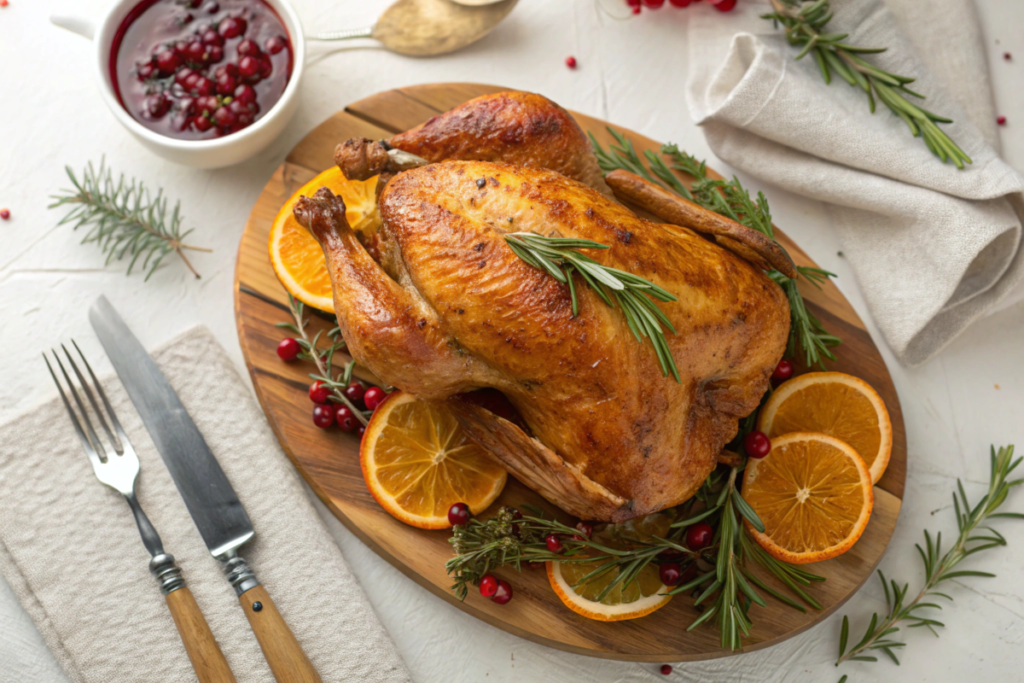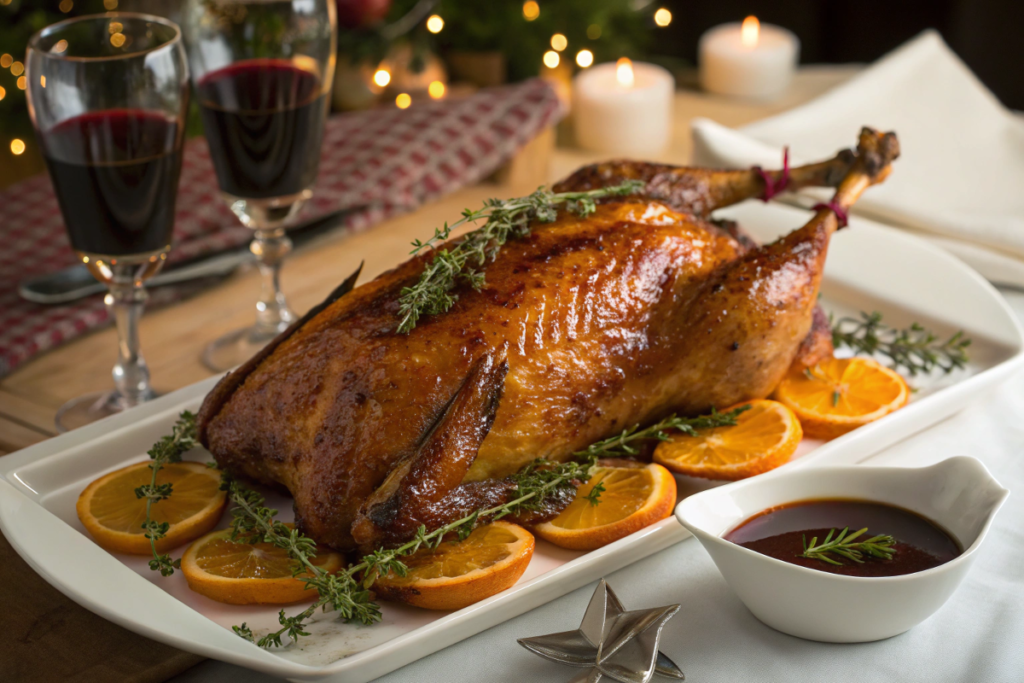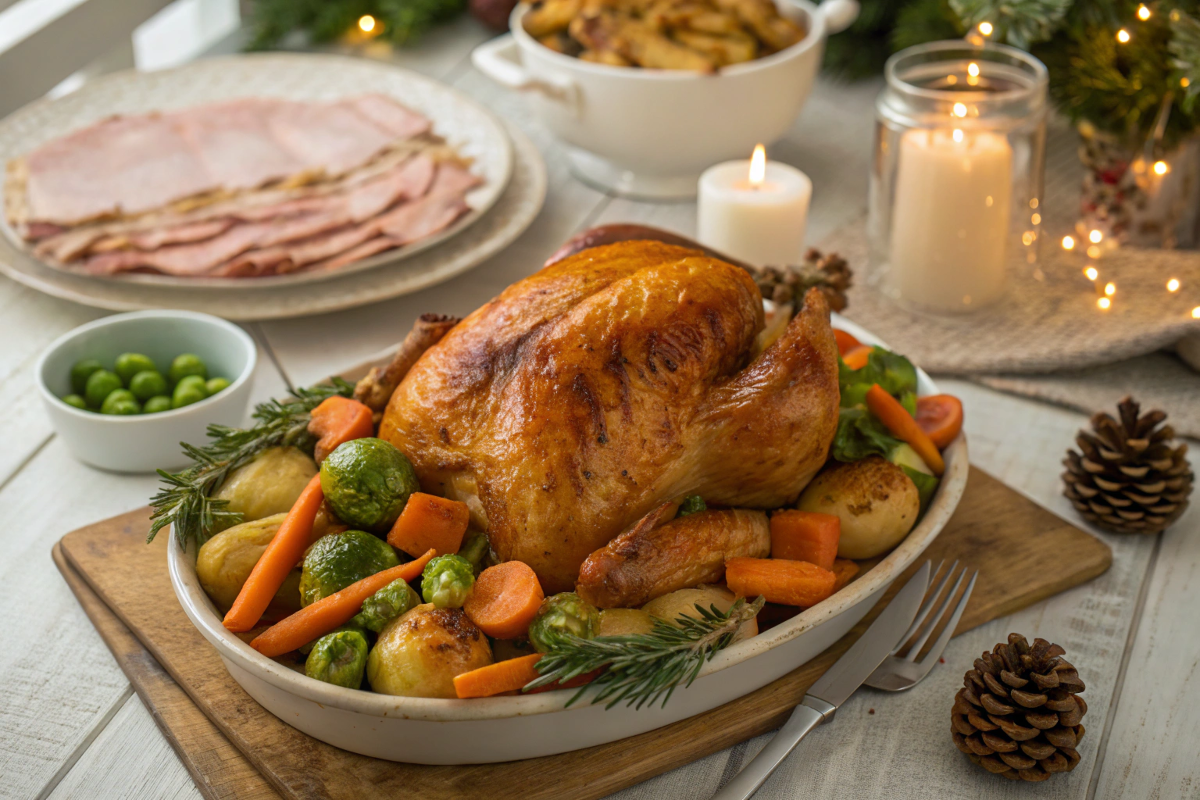Historical Background of Christmas Dinner Meats
The tradition of serving meat at Christmas dinners has a long and rich history. Rooted in cultural and religious practices, what is the most popular meat for Christmas dinner? This question often reflects the symbolism of abundance, togetherness, and celebration. Exploring the origins and significance of meat in festive feasts reveals why it remains a centerpiece of holiday traditions worldwide. For tips on simplifying your holiday feast, visit How to Make Christmas Dinner Easy.
Origins of Christmas Dinner Traditions
The history of Christmas dinner dates back to ancient times, long before the holiday became associated with Christianity.
- Pagan Celebrations: Early winter solstice festivals, such as Yule in Scandinavia and Saturnalia in Rome, featured grand feasts. Meat played a key role during these events, marking the end of the harvest season. People often slaughtered livestock to avoid feeding them through the harsh winter.
- Christian Influence: As Christianity spread, these feasting traditions merged with celebrations of Christ’s birth. During the Middle Ages, Christmas became a time for family gatherings and feasting. Meat symbolized abundance and blessings, making it central to the meal.
These traditions laid the foundation for today’s Christmas dinners, where meat often takes center stage.
Role of Meat in Festive Feasts
Meat has been a central part of Christmas dinners for centuries. It holds both symbolic and practical significance.
- Symbol of Prosperity: Serving meat during Christmas represented wealth and generosity. It was reserved for special occasions due to its cost and availability.
- Traditional Choices:
- Roast Goose: In medieval Europe, goose was a popular choice because of its size and ability to feed large families.
- Turkey: Introduced to Europe from the Americas in the 16th century, turkey became the preferred Christmas meat in countries like the UK and the US. Its mild flavor and large size made it ideal for festive gatherings.
- Ham and Pork: In Scandinavian and Germanic traditions, pork symbolized good fortune. It became a centerpiece of many holiday feasts.
- Lamb and Beef: These meats were common in Mediterranean and Middle Eastern Christmas celebrations, reflecting regional availability and culinary traditions.
Today, traditional meats remain a key part of Christmas celebrations, reflecting cultural and regional preferences.
Christmas dinner meats carry a historical legacy that highlights their importance in festive feasts. From ancient solstice celebrations to modern holiday meals, they symbolize abundance, community, and joy. Whether you prefer turkey, ham, or roast beef, these dishes continue to bring families together during the holiday season.
The Top Meat Choices for Christmas Dinner
Meat often takes center stage at Christmas dinners, bringing flavor and warmth to the holiday table. From the iconic turkey to the savory richness of ham and the boldness of roast beef, each option adds its own charm to the festive meal.
Turkey: The Holiday Staple
Turkey is widely considered the star of Christmas dinners in many homes.
- Why It’s Popular: Its size is ideal for feeding a crowd, and its mild flavor pairs perfectly with various side dishes.
- Preparation Tips:
- Consider brining the turkey to retain moisture and enhance its flavor.
- For a delicious finish, roast it with a blend of herbs, butter, and garlic to achieve crispy skin and juicy meat.
- Serving Suggestions: Pair the turkey with cranberry sauce, stuffing, and gravy to create a classic holiday experience.
As a traditional choice, turkey represents the heart of a festive family gathering.
Ham: A Festive Favorite
Ham offers a sweet and savory combination that’s hard to resist.
- Why It’s Popular: It is easy to prepare and stays moist, making it a reliable option for hosts.
- Preparation Tips:
- To achieve a caramelized glaze, coat the ham with honey, brown sugar, or maple syrup.
- Baking it slowly allows the flavors to deepen while keeping the meat tender.
- Serving Suggestions: Complement the ham with roasted vegetables, mashed potatoes, or cornbread for a well-balanced meal.
This versatile meat’s simplicity and flavor make it a popular choice for the holidays.
Roast Beef: A Classic Choice
For a rich and flavorful alternative, roast beef delivers a bold option for Christmas dinner.
- Why It’s Popular: Its hearty flavor and luxurious texture make it a standout dish.
- Preparation Tips:
- Season the beef generously with salt, pepper, and garlic, then roast it to the desired level of doneness.
- Using the drippings to make a savory gravy adds an indulgent touch.
- Serving Suggestions: Pair the beef with Yorkshire pudding, horseradish sauce, and roasted potatoes for a traditional pairing.
Roast beef offers a sophisticated and satisfying option for any festive gathering.
Whether you choose turkey, ham, or roast beef, each of these meats contributes something special to your Christmas feast. By selecting the one that best suits your traditions and preferences, you can create a holiday meal that is both memorable and delicious.

Regional Preferences in Christmas Dinner Meats
Christmas dinner traditions vary greatly across the globe, with each region showcasing its unique preferences for festive meats. From classic turkey and ham to barbecued specialties, these choices reflect cultural influences, seasonal factors, and culinary heritage.
United States: Ham vs. Turkey
In the United States, ham and turkey often compete for the spotlight at Christmas dinners.
- Turkey: Many families serve roasted turkey, similar to Thanksgiving, but with holiday-specific sides like cranberry sauce, stuffing, and gravy. Its versatility and ability to feed large gatherings make it a popular choice.
- Ham: Glazed ham offers a sweet and savory alternative. It’s easier to prepare and often comes pre-cooked, which reduces stress for hosts. Honey or brown sugar glazes enhance its flavor, making it a festive favorite.
- Regional Preferences: Southern states may lean toward ham, while turkey remains more common in the Midwest and Northeast.
Both meats provide a centerpiece that reflects American holiday traditions and family preferences.
United Kingdom: Goose and Other Traditional Meats
In the United Kingdom, goose has long been a traditional choice for Christmas dinner.
- Goose: Historically, goose was more accessible than turkey and became a staple of holiday feasts. Its rich, flavorful meat pairs well with sides like roasted potatoes, Brussels sprouts, and gravy.
- Turkey: Introduced in the 16th century, turkey has gradually overtaken goose as the most popular Christmas meat. It is milder in flavor and easier to prepare for large families.
- Other Choices: Beef Wellington, roasted lamb, and game meats like venison or pheasant also feature on many Christmas menus, particularly in rural areas.
The UK’s Christmas meats showcase a blend of tradition and adaptability, catering to both classic and modern tastes.
Australia and New Zealand: Barbecued Options
In Australia and New Zealand, the warm summer weather shapes Christmas dinner menus, making barbecued meats a popular choice.
- Barbecued Ham or Turkey: Instead of roasting, many families grill or barbecue their Christmas meats outdoors, giving them a smoky flavor.
- Seafood: Prawns, lobster, and fish often replace traditional meats, reflecting the region’s coastal culture and access to fresh seafood.
- Other Barbecue Favorites: Lamb chops, sausages, and even kangaroo or venison can make appearances, offering a unique twist on the holiday meal.
These outdoor celebrations reflect the laid-back and sunny atmosphere of Christmas in the Southern Hemisphere.
Regional preferences for Christmas dinner meats highlight the diversity of holiday traditions worldwide. Whether you enjoy a roasted turkey in the United States, a flavorful goose in the UK, or a barbecue feast in Australia, these choices reflect the unique ways cultures celebrate the season.
Why Turkey is the Most Popular Choice
Turkey has become synonymous with Christmas dinner in many parts of the world. Its rich history, symbolic meaning, and practical benefits make it a go-to choice for holiday celebrations.
Symbolism of Turkey in Christmas Celebrations
The tradition of serving turkey during Christmas has deep cultural and symbolic roots.
- Historical Significance: Turkey became popular in Europe during the 16th century when it was introduced from the Americas. Its size and ability to feed large families made it an ideal centerpiece for festive gatherings.
- Symbol of Abundance: Serving turkey symbolizes generosity and abundance, aligning with the holiday’s themes of sharing and togetherness. Its presence on the table often represents prosperity and gratitude.
- Tradition Over Time: Over centuries, turkey has solidified its role as a Christmas staple, particularly in the United States, the United Kingdom, and Canada, where it is often roasted and paired with seasonal sides.
The turkey’s symbolic value makes it more than just a meal; it is a representation of holiday cheer and unity.
Nutritional Benefits and Versatility
Beyond its cultural significance, turkey is also a practical and versatile choice for Christmas dinner.
- Nutritional Benefits:
- Turkey is a lean source of protein, making it a healthier option compared to fattier meats.
- It is rich in vitamins and minerals, such as B vitamins, zinc, and selenium, which support energy and immune function.
- Versatility:
- Flavor Pairings: Turkey’s mild flavor pairs well with a wide range of sides, including stuffing, cranberry sauce, and roasted vegetables.
- Cooking Options: While roasting is the most common method, turkey can also be smoked, grilled, or stuffed with herbs and fruits for added flavor.
- Leftover Potential: Turkey leftovers can be transformed into sandwiches, soups, or casseroles, making it an economical choice.
Its combination of health benefits and adaptability ensures turkey remains a favorite for Christmas celebrations.
Turkey’s popularity as a Christmas dish stems from both its historical symbolism and practical advantages. As a symbol of abundance and a versatile ingredient, it continues to bring families together, offering a meal that is both meaningful and delicious.
Why Ham is a Festive Favorite
Ham has earned its place as a beloved centerpiece for Christmas celebrations. Its rich history, cultural significance, and variety of options make it a versatile and crowd-pleasing choice for the holiday table.
Historical and Cultural Significance
Ham’s association with Christmas is rooted in centuries of tradition.
- Pagan Origins: In pre-Christian Europe, pagans celebrated the winter solstice by feasting on pork, which symbolized prosperity and good fortune. This practice carried over into Christmas feasts as the holiday evolved.
- Religious Symbolism: In Christian traditions, ham became a symbol of abundance and generosity, often served to celebrate the conclusion of Advent fasting.
- Accessibility: Historically, ham was easier to preserve and store than fresh meat, making it an ideal choice for winter feasts when fresh meat was scarce.
These cultural and historical ties have solidified ham’s role as a festive staple for holiday meals.
Varieties of Ham for Christmas
Ham’s versatility makes it suitable for a wide range of Christmas menus.
- Smoked Ham: Known for its rich, smoky flavor, this variety is a classic choice for traditional holiday feasts.
- Glazed Ham: A sweet glaze made with honey, brown sugar, or maple syrup adds a caramelized crust, making it a show-stopping centerpiece.
- Bone-In Ham: Retaining the bone enhances flavor and adds a rustic touch to the meal, perfect for carving at the table.
- Spiral-Cut Ham: Pre-sliced for convenience, this option is ideal for large gatherings, allowing guests to serve themselves with ease.
Each variety brings a unique flavor profile and presentation, ensuring there’s a perfect ham for every table.
Ham remains a festive favorite for Christmas due to its rich history, cultural significance, and endless versatility. Whether you choose a traditional smoked ham or a sweetly glazed version, this timeless dish adds warmth and flavor to any holiday celebration.
Alternative Christmas Meat Options
While turkey and ham often dominate Christmas tables, many families explore alternative meats to diversify their holiday feasts. Options like lamb, duck, and venison offer unique flavors and elevate the dining experience. These choices bring sophistication and a personal touch to festive celebrations.
Lamb: A Mediterranean Choice
Lamb is a flavorful and tender option, perfect for those seeking a departure from more traditional meats.
- Why It’s a Favorite: Known for its slightly gamey taste, lamb pairs beautifully with Mediterranean herbs and spices. Its bold flavor adds a unique twist to the Christmas meal.
- Preparation Tips:
- For a classic approach, roast lamb with garlic, rosemary, and olive oil.
- Alternatively, serve it with a mint sauce or tzatziki for a refreshing contrast.
- Perfect Pairings: Roasted vegetables, couscous, or a crisp green salad complement lamb’s rich taste.
Choosing lamb introduces a touch of elegance to your Christmas table.
Duck: A Luxurious Alternative
Duck is ideal for those who want a rich, indulgent dish that makes an impression.
- Why It’s a Favorite: Its tender, flavorful meat combined with crispy skin creates a decadent centerpiece for festive occasions.
- Preparation Tips:
- Enhance the flavor by glazing the duck with orange or cranberry sauce.
- To achieve a crispy skin, score it carefully to allow the fat to render while roasting.
- Perfect Pairings: Wild rice, sautéed greens, or roasted potatoes work wonderfully as side dishes. Pair with a cherry reduction for added depth.
Duck’s luxurious flavor and presentation make it a standout choice for the holidays.
Venison: For a Rustic Celebration
Venison offers a rustic charm, perfect for creating a unique and hearty Christmas dinner.
- Why It’s a Favorite: Lean and slightly gamey, venison reflects traditional winter feasts and is particularly popular in rural areas.
- Preparation Tips:
- Slow-cook venison in red wine and herbs for a tender, flavorful dish.
- For a quicker option, grill venison steaks and top with a rich mushroom or peppercorn sauce.
- Perfect Pairings: Pair venison with mashed sweet potatoes, roasted root vegetables, or a red wine reduction.
With its earthy flavor and versatility, venison transforms any Christmas meal into a memorable celebration.
Alternative Christmas meats like lamb, duck, and venison provide delicious ways to customize your holiday feast. By exploring these options, you can offer a meal that stands out while embracing the festive spirit of the season.

FAQs About Popular Meat For Christmas Dinner
What is the best way to cook turkey?
Roast the turkey after brining it to keep the meat moist. Baste it with butter and herbs for added flavor.
Can you prepare Christmas ham in advance?
Yes, you can glaze and cook ham a day ahead. Reheat it gently before serving to retain its flavor.
What is a good vegetarian alternative to meat for Christmas dinner?
Stuffed squash, mushroom Wellington, or lentil loaf are excellent vegetarian options for a festive main dish.
Conclusion
Exploring alternative Christmas meats like lamb, duck, and venison adds variety and sophistication to your holiday feast. Each option brings unique flavors and charm, allowing you to craft a memorable meal that reflects your personal style.
By embracing these choices, you can create a festive celebration that stands out while honoring the joy and warmth of the season.

